
Thank you for your interest in Creative Acres. We have information that we hope will make a difference and that you might find educational. If you donate to any shelters, or plan to, you will want to read this. Too much money is being donated to some shelters that are not moving forward or are giving up on animals far too easily. Your money may not be going where you think. This information is not limited to only domesticated animals but to exotics and farm animals.
Some shelters hide behind certain words and situations. They may use misleading terms such as no-kill adoptable, open door policies, 100% placement of adoptable animals, etc. These shelters also boast that they take in thousands of animals but fail to mention that they kill thousands too. Some of these shelters might kill for such minor reasons as the animal is fearful, high costs of medical treatment, or the animal is too old or pregnant. Some may say at least the shelter is saving some animals. However, the situation may be that they have the capacity to save more animals and do not. Can you justify and excuse these actions with rewards? We understand that animals must be destroyed due to over population; however, these actions are typically carried out by agencies known as city shelters, not rescue groups.

When an organization says their goal is to become 100% adoptable or they state that they are 100% adoptable, this is not an achievement to Creative Acres. It is only a play on words. This only means that this organization can still hide behind the word ADOPTABLE or UNADOPTABLE. This is a loophole that gives them very open guidelines to kill animals. If you have ever talked to organizations and then to other people who are involved in these types of organizations, the reasons for killing an animal in usually different.
Think about shelters that keep animals in a poor environment; such as cages that are too small, unsanitary conditions, or administer inadequate medical care. These shelters may prey on your guilt by making statements such as, “help us or these animals will never make it.” Is this the sign of an incompetent or unethical organization? We know situations can arise that may upset the organization; but there is no reason, in the case of an efficiently-run operation, that their philosophy for protection and care of animals should be forgotten. Many shelters use the words, “we hope to become a no-kill shelter someday.” This may be considered a string-along tactic for the public. You don’t have to hope to not kill someday, you just don’t kill. Many of these shelters that use this approach have existed for years making thousands, even millions of dollars, yet there is no part of their organization that is truly no-kill. Creative Acres has offered some shelters in this area assistance to add, or become a no kill free roam, or just improve the conditions, but they declined.
We also have stories in the media about the public harming animals and a shelter stepping in to save the animals. Do you ever wonder just what happens to those animals in the shelter? How can these shelters, which say they have no room for their existing animals, always manage to find room for another animal when the media are involved? Then there are also shelters that have behaviorists and trainers on staff, yet kill the animals for bad behavior. Are they incompetent or do they only spend their time training the animals whose owners can afford it?

There are shelters that are truly no-kill. It is wonderful that the animals are not euthanized but they live their lives in cages. Their quality of life would be enriched if the shelter were a free roam. Establishing a no-kill, without being free-roam, is doing only half the job. Unfortunately, the same poor conditions and the same reasons given by kill shelters are found here.
Don’t be fooled by shelters that tell you they cannot manage or change because of budgetary constraints. Our suggestions, which have been shared with many shelters, are to decrease high salaries and limit employees. Should someone be making a high salary if they are not efficient at accomplishing a shelter’s mission and goals? Some shelters will say they have limited facilities. An option could be as simple as reducing spending on new buildings and buy land. Rural land can be obtained at half the cost and houses more animals in comfort. Also, less money spent on commercials and appealing informational packages could help accomplish this goal. If the budget were done correctly, it would not affect their existing shelters to move forward to start a no kill free roam.

Some shelters use words but do not fulfill their definitions. As an example, some use “protect” to keep from harm, yet they euthanize. Some may say this is harmful. Another example, they use the word “rescues.” They take animals from one location to another knowing the new facility’s guidelines do allow euthanasia, or do not allow quality of life and a full recovery. Our opinion is that they are just re-locators, not rescuers. There are also shelters that call themselves “humane” shelters, but they are kill shelters.
There are some kill shelters that turn the table and say that a kill shelter will not refuse any animal, but a no kill will. It is a shame to call this an achievement, to let any animal into your building to be destroyed. If there is a need to compare, it should be how the public kill shelters compare to city shelters. An alternative may be to eliminate the kill shelter that does the same job as the city shelter. There should be separate county and public shelters to avoid confusion of funding. This would also regulate salaries. Instead of the shelter determining the salary, the city would. They should use public funding for the efforts to create efficient, happy, and safe no kill free roam shelters.
Creative Acres also works with therapy animals. The animals here roam free, whether they are in training or not. But do you know the conditions of therapy animals in other organizations? Most of these animals spend time locked in cages when not in training or providing a service. If they are lucky someone will take them home for an overnight stay. These animals are subject to be trained at times with choker collars, pinch collars, and gentle leaders. These animals are not being trained for aggression or they wouldn’t be in a service training program. So why the pain tactics? These animals should be honored rather than punished. They should have the best living conditions because they will dedicate their whole lives to the service of humans. Creative Acres has proved that you can offer these services to preserve the respect and freedom of our working animals.
Creative Acres has recently experienced much hardship, but we succeeded. We had to relocate our entire facility on a very limited budget. We did not kill or abandon any of our 140+ animals. We made no excuses. We achieved our goals. Our thinking was positive and we moved in a forward direction, not negative and destructive. We have proven for 13+ years that a true no kill, free roam shelter can be successful. We continue to move in a positive direction while clearing a path for other shelters to follow. We need to get the right people in the right positions of leadership. Education and strength will change the way of the future of shelters, but we need you to speak for those who cannot. Creative Acres’ goals are to expand by acquiring more land to grow our concept not only here but also in other states.
The public needs more information. Ask more questions and research the answers. Your donation is important not only to the individual group, but also to the future of the animal world. Please donate wisely.
We appreciate your donations. We are not suggesting that donations are limited to us, but only that you carefully consider which organization really deserves your support. Any questions or suggestions you may have, please write or call us at P.O. Box 1143, Brighton, Colorado 80601, (303) 659-4792.

Remember, “Dreams can come true if you don’t make them wishes.” Thank you for making dreams come true for the animals here at Creative Acres.
If you have a concern about an organization, please put it writing and mail it to us at P.O. Box 1143, Brighton, Colorado 80601.
